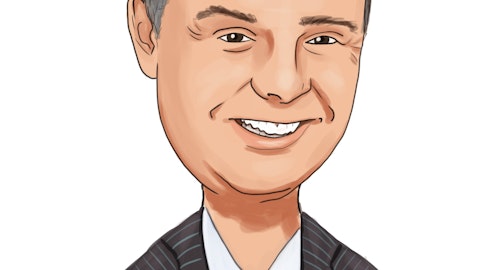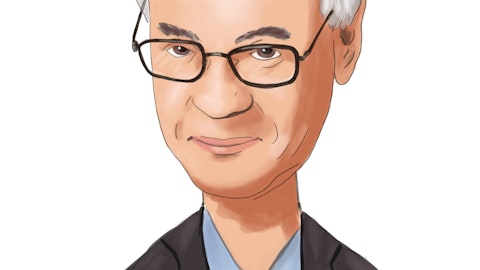Oportun Financial Corporation (NASDAQ:OPRT) Q4 2022 Earnings Call Transcript March 13, 2023
Operator: Hello and welcome to the Oportun Financial Fourth Quarter 2022 Earnings Conference Call and Webcast. A question-and-answer session will follow the formal presentation. As a reminder, this conference is being recorded. It’s now my pleasure to turn the call over to Dorian Hare, Vice President of Investor Relations. Please go ahead, Dorian.
Dorian Hare: Thanks, and hello everyone. With me to discuss Oportun’s fourth quarter 2022 results are Raul Vazquez, Chief Executive Officer; and Jonathan Coblentz, Chief Financial Officer and Chief Administrative Officer. I’ll remind everyone on the call or webcast that some of the remarks made today will include forward-looking statements related to our business, future results of operations and financial position, planned products and services, business strategy and plans and objectives of management for our future operations. Actual results may differ materially from those contemplated or implied by these forward-looking statements, and we caution you not to place undue reliance on these forward-looking statements. A more detailed discussion of the risk factors that could cause these results to differ materially are set forth in our earnings press release and in our filings with the Securities and Exchange Commission under the caption, Risk Factors, including our upcoming Form 10-K filing for the current quarter ended December 31, 2022.
Any forward-looking statements that we make on this call are based on assumptions as of today, and we undertake no obligation to update these statements as a result of new information or future events other than as required by law. Also on today’s call, we will present both GAAP and non-GAAP financial measures, which we believe can be useful measures for the period-to-period comparisons of our core business, and which will provide useful information to investors regarding our financial condition and results of operations. A full list of definitions can be found in our earnings materials, available at the Investor Relations section on our website. Non-GAAP financial measures are presented in addition to and not as a substitute for financial measures calculated in accordance with GAAP.
A reconciliation of non-GAAP to GAAP measures is included in our earnings press release, our fourth quarter 2022 financial supplement and the appendix section of the fourth quarter 2022 earnings presentation, all of which are available at the Investor Relations section of our website at investor.oportun.com. In addition, this call is being webcast, and an archive version will be available after the call, along with a script of our prepared remarks. With that, I will now turn the call over to Raul.
Raul Vazquez: Thanks, Dorian and good afternoon, everyone. Thank you for joining us. Today, I’d like to discuss our fourth quarter financial performance, share how we are managing through the macroeconomic environment, and provide an update on our strategic initiatives. Jonathan will then provide more details on our financial performance and our guidance, and I’ll provide some closing remarks. Oportun delivered strong, top-line growth in the fourth quarter and was profitable on an adjusted basis. Let me start with the following summary on Slide 3 of our earnings deck. We delivered fourth quarter record revenue of $262 million, up 35% year-over-year. We exhibited diligent expense management with a 52% adjusted operating efficiency ratio.
That’s a new record for us as a public company and a key driver of our profitable quarter, with adjusted net income of $4.6 million, for adjusted EPS of $0.14. While our post-July vintages are performing better or near 2019 pre-pandemic levels and continue to grow as a proportion of our loan portfolio, our annualized net chargeoff rate of 12.8% was higher than our prior expectations due to underperformance of our back book of loans originated before our July credit tightening. The positive trends in our post-July vintages provide us with the expectation that Oportun will continue to see its loss rates trend toward our target range during 2023. On a full-year basis, 2022 was a resilient year in the face of a challenging macroeconomic backdrop.
We grew total revenue by 52% to a record $953 million, while total originations grew by 27% despite significant credit tightening actions in the second half of the year. And Oportun was profitable on an adjusted basis, generating $69 million in adjusted net income and $2.09 in adjusted EPS. The initial 2023 guidance that Jonathan will detail with you reflects that although we still face headwinds in the first quarter, we anticipate strong performance starting in Q2, driven by prudent originations, lower losses and expense reductions. Now, let me update you in more detail about what we saw in Q4, starting with credit. Credit is the most important metric in our business. As a reminder, starting in July we initiated a set of actions, including significantly tightening our underwriting standards, to address the impact of inflation on our members.
At the time we observed an uptick in delinquencies, particularly among borrowers with lower free cash flows and those with smaller loans with shorter maturities whom we had underwritten prior to or in the first half of 2022. This subset of borrowers, including new and some returning, struggled with the expiration of pandemic-era stimulus payments amidst rising inflation. As you can see from Slide 4, our post-July underwriting vintages continue to perform quite nicely. We’ve maintained our posture of reducing our exposure to new borrowers and increasing our proportionate exposure to more profitable, returning borrowers, who have already successfully repaid at least one loan to Oportun. In the fourth quarter, 27% of our loans were to new borrowers as compared to 28% in the third quarter and 51%, in the first quarter.
This shift in underwriting has been integral towards our driving first payment defaults towards or below 2019 pre-pandemic levels. As of the end of 2022, our first payment default rate was markedly lower than where we started the year and stood at 0.6% in comparison to 1.0% in 2019. We initiated further credit tightening actions in November and December, following the July actions. On an overall basis, as you can see on Slide 5, the 30 plus day delinquency rates for our August through November 2022 vintages were each lower than the comparative monthly vintages initiated in 2019. Moreover, as the average life of our loans is only one year, the proportion of post-July underwritten personal loans on our balance sheet was already up to 39% as of the end of the fourth quarter 2022, and we anticipate it will be 81% by the end of 2023.
So, we’re very pleased with the results from our originations following our July credit tightening and our subsequent actions which position us to improve our credit performance throughout 2023. We remain highly focused on other key pillars of preparedness in this macro environment, including pricing, funding, liquidity and cost controls. We continue to pursue loan portfolio pricing actions to mitigate the increased costs of funds we’re experiencing in this rising rate environment, while remaining committed to our 36% APR cap. We now expect that by the end of 2023 our portfolio yield will be over 200 basis points higher than the end of 2022. We closed a $300 million securitization, our fourth of the year, in November, and we believe our access to the securitization market remains strong.
We are making progress in reducing our charge-off rate, but given the performance of our back book, expected higher cost of funds given Fed actions to combat persistent inflation, and the uncertain future macro environment, we have recently taken two additional measures to bolster our liquidity position. We have delayed $42 million of amortization on our residual financing facility, and we have upsized and amended our senior secured term loan by up to $75 million. Jonathan will detail these changes with you later. Let me shift now to operating expenses. We are pleased to have met our target for flat second half adjusted operating expenses versus the first half of the year by reducing sales marketing costs and limiting headcount growth, while continuing to grow our revenue.
Accordingly, our fourth quarter adjusted operating efficiency improved by over 1,200 basis points year-over-year to 52%, which is the lowest level in our history since becoming a public company in 2019. As we entered 2023, we remained focused on reducing operating expenses. I recently made the decision to reduce our corporate staff by 10% and eliminated a number of contractor relationships as part of an overall plan to streamline operations. These actions will result in $48 million to $53 million in total annualized expense savings. Shifting now to our long-term strategic priorities, I’d like to provide you with our key areas of focus for this year and into 2025 as we’ve laid out on Slide 7. Our first priority is to fortify our core business economics.
I’ve talked to you about how our underwriting focus has been on returning members rather than on new members, and we look forward to the second quarter and beyond when we anticipate lower charge-offs. We’re also focused on substantially improving our profitability and our ROE. We expect the expense discipline and record-low adjusted operating efficiency levels we exhibited in the second half of 2022 to carry into this year and beyond. Our second priority is to strengthen our core unsecured personal loan product, with a focus on improving unit economics. As I mentioned earlier we are increasing yield and are focused on reducing costs associated with our personal loans business. Our unsecured personal loan portfolio will continue to be the most profitable component of our business, and we will leverage data, technology and AI to responsibly grow it.

Pixabay/Public Domain
Our third priority is to build our member engagement platform. We’re continuing to enhance our platform capabilities to meet the everyday financial needs of hardworking people, which will extend member lifecycles and enable us to service them with more personal loans over time. At the center of this engagement initiative is our Oportun Mobile App, which we previously referred to as the Unified App. Released in February, the Oportun Mobile App combines our credit products with our digital saving, banking and investing products. I’ll talk more about the mobile app in a moment. Finally, our fourth strategic priority is to develop our product suite. This includes our focus on credit cards, secured personal loans, and our lending-as-a service partner channel.
As a reminder, we indicated on our August earnings call that we would deliberately moderate growth in our secured personal loan and credit card products as part of our credit tightening actions. While in the near-term we will be focused on improving the credit performance of these portfolios and limiting originations, we continue to believe that secured personal loans and credit cards are complementary to our overall product suite. And we continue to make great progress with our lending-as-a-service partner channel, from which we can efficiently increase our applicant pool and selectively add high quality new members even while we tighten our credit standards. During the fourth quarter, we scaled our partner network to include 590 locations, up from 258 a year ago, and well in excess of the 500 locations we had targeted by year-end.
I’m also pleased to share with you that our partnership with Sezzle, the Buy Now, Pay Later company and our first digital Lending-as-a-Service relationship, is active as of February. Oportun will be providing financing for Sezzle’s customers who need a larger loan, for whom a traditional Buy Now, Pay Later loan is not a fit. To elaborate further on the new Oportun Mobile App that I mentioned earlier, we’re very excited about its release because it is a major milestone towards building our member engagement platform to help hardworking individuals meet their borrowing, saving, budgeting, and spending needs. Over 275,000 members have already used our app. Many of you will recall that in November of 2021 when we announced the acquisition of Digit, our Digital Banking platform, we began to refer to our customers as members.
The implicit strategy shift was that the Digital Banking products would allow for ongoing engagement with existing and new borrowers with whom we could formulate multiproduct relationships. With the Oportun Mobile App’s launch and the seamless customer experience it provides, we are now well-positioned to accelerate the synergies we contemplated when we acquired Digit, through increased cross-selling, higher conversions and lower customer acquisition costs. With that, I’d like to turn it over to Jonathan for additional details on our fourth quarter financial performance and our initial 2023 guidance.
Jonathan Coblentz: Thanks, and good afternoon everyone. As Raul mentioned, we’re pleased with the resilience that Oportun continued to exhibit in the fourth quarter. Although, we still face challenges in the first quarter of this year from our pre-July back book, I am optimistic about the improvements we anticipate to follow and how they will position us for strong future growth and profitability. In the fourth quarter, we generated $262 million of total revenue as shown on Slide 9, and $4.6 million of adjusted net income, or $0.14 of adjusted EPS. Revenue upside and expense discipline enabled us to be profitable, while higher charge-offs resulted in a slight earnings shortfall in comparison to our November guidance. Our aggregate originations were $610 million, down 29% year-over-year and below our prior guidance of between $650 million to $700 million for the quarter.
This reflects the further credit tightening actions we took in November and December, and our ongoing focus on high-quality originations. Total revenue of $262 million was above the guidance range and up 35% year-over-year, with upside reflecting outperformance in our Digital Banking business. Net revenue was $143 million, down 11% year-over-year due to a net decrease in the fair value of the Company’s loans and increased interest expense, partially offset by increased revenue. Interest expense of $36 million was up 211% year-over-year, primarily driven by increased debt issuance to fund our growth, and the increase in our cost of debt to 5% versus 2.5% in the year-ago period. At the end of the fourth quarter, 82% of our debt was fixed rate, providing us with some protection from rising interest rates.
For our net change in fair value, we had an $83 million net decrease, which consisted mainly of current period charge-offs of $99 million. For the mark-to-market, the fair value price of our loans increased to 101.5% as of December 31, and resulted in a $23 million mark-to-market increase. The $21 million mark-to-market increase in our asset-backed notes resulted from a 47 basis point decrease in the weighted average price to 92.5%, due to the increase in interest rates and credit spreads during the quarter. Turning to expenses, we maintained strong discipline as we said we would on our prior call with adjusted operating expenses only increasing 1% sequentially. This allowed us to meet our objective for flat second half vs. first half expense.
As you can see on the right side of Slide 9, Adjusted Operating Efficiency at 52% was a year-over-year improvement of over 1,200 basis points and was, as Raul mentioned, a new post-IPO record. We’ve carried this expense discipline into 2023. As you heard Raul mention, we expect to save $48 million to $53 million in annualized run rate savings from our recently announced plan to streamline operations. In the fourth quarter, our sales and marketing expenses were $21 million, down 2% sequentially and down 43% year-over-year, as part of our continued cost cutting focus. Our customer acquisition cost was $152, up 13% from the prior year period as lower marketing expenditures were offset by lower aggregate originations due to credit tightening. We delivered adjusted net income of $4.6 million, compared to $26 million in the prior year quarter, and adjusted EPS of $0.14 versus $0.82, respectively.
Adjusted EBITDA was a $33.5 million loss in the fourth quarter, a $57 million decrease compared to a gain of $23 million in the prior-year quarter. The decline was primarily driven by higher net charge-offs and the fair value mark on loans sold during the more recent quarter. Adjusted Return on Equity was 3% versus 18% in the prior year quarter. For the last 12 months, Adjusted ROE averaged 12%. Turning now to credit as shown on Slide 10, our fourth quarter annualized net charge-off rate was 12.8%, compared to 6.8% in the prior year period, while the full year rate was 10.1%. As a reminder, last year’s charge-off rate was abnormally low due to strong consumer balance sheets, including the impact of government stimulus amidst the pandemic. Losses were $5 million higher than the top of our fourth quarter guidance range of 12.15%.
As we said on our third quarter earnings call, our credit performance has been and will continue to be driven by two different portfolio dynamics: the loans we’ve been originating since July under significantly tighter credit standards and the loans originated prior to that. We continue to expect 4Q 2022 to be the peak charge-off level during the current credit cycle, with our charge-off rate declining in the first and second quarters and being markedly lower in the second half of 2023. Regarding our capital and liquidity, as of December 31, total cash was $204 million. Additionally, net cash flow from operations for the fourth quarter was $89 million, up 48% year-over-year. Our debt-to-equity ratio was 5.3 times. Also as of December 31, $430 million of our combined $750 million in warehouse lines was undrawn and available to fund our growth.
As Raul talked about, we recently amended our two corporate debt facilities as follows: first, we amended our residual financing facility. We deferred $42 million of scheduled principal payments into 2024 that otherwise would have been due through July of this year. Second, we upsized and amended our senior secured term loan to be able to borrow up to an additional $75 million. We borrowed the first $21 million on March 10 and will receive $14 million more by the end of the month. We expect to borrow additional $25 million amounts in April and June, subject to the approval of our lenders. In consideration of these actions, the rates we pay on these two facilities have increased by 3 percentage points each. Furthermore, we have issued warrants for common stock representing approximately 5% of the company to the senior secured term loan lender in connection with the initial draw.
We would issue additional warrants for approximately 2.5% upon each of the two further conditional draws. In this uncertain macro environment, forecasting losses on our back book has been challenging, and recognizing that further macro headwinds could additionally pressure our portfolio, we felt it was prudent to increase our liquidity position with these actions. We believe our future performance will more than make up for the associated costs. Turning to our expectations for the first quarter and full year 2023 as shown on Slide 12, we remain focused on prudent, profitable growth and our forecast reflects that our tightened credit posture will persist until we see our charge-off rates coming down, the Federal Reserve moderating their interest rate hikes, and the macroeconomic outlook improving.
I want to let you know that for the time being we will not be providing guidance for Adjusted Net Income and Adjusted EPS because of the potential for increased volatility in the fair values of our loans and ABS notes. While we expect profitability to improve starting in 2Q, setting us up for a strong 2024, we expect the non-cash fair value mark-to-market to cause us to have a significant loss in the first quarter of 2023. We will look to reinstate our adjusted net income and adjusted EPS guidance in the future when the macroeconomic environment has stabilized. Given the decision not to guide at this time to adjusted net income and Adjusted EPS, we are reintroducing our adjusted EBITDA guidance. We continue to believe that adjusted EBITDA is a useful metric because it represents the cash flow generation capability of the business, and it isn’t impacted by swings in fair value.
While we still expect that the fourth quarter of 2022 was our peak charge-off rate, and we expect to see improvement throughout 2023, I do want to point out that we now do not anticipate returning to our 7% to 9% charge-off rate in the second half of the year. At this time, we do expect significant improvement of over 200 basis points and to approach a charge-off rate of 10% by the second half. This change in expectations is caused by our back book recently performing worse than previously expected. In addition, we’ve observed indications from the latest IRS reporting that average refunds are trending around $400 lower than last year. We believe this could be impacting the ability to pay of members with lower free cash flow. Finally, we are not providing originations guidance at this time because if the macro environment were to worsen, we plan to tighten credit which would reduce our loan volumes.
What we can share is that we generally expect at most single-digit growth in our owned receivables balance this year, as we keep credit tight and plan to restart whole loan sales. In terms of guidance, our outlook for the first quarter is, total revenue of $245 million to $250 million, annualized net charge-off rate of 12.5% plus or minus 15 basis points, adjusted EBITDA of $49 million to $44 million. Our guidance for the full year is, total revenue of $975 million to $1,000 million, annualized net charge-off rate of 11.5% plus or minus 50 basis points, adjusted EBITDA of $52 million to $60 million. In summary, we continue to take the necessary steps to manage our back book, diligently manage our expenses, and make high quality loans. And above all, we are focused on improving our profitability.
With that, I will now turn it back over to Raul before we open the line for questions.
Raul Vazquez: Thanks, Jonathan. As we’ve communicated, we believe our peak charge-off rates are behind us and the business will see steady improvement beginning in the second quarter. The leadership team and I remain confident in our ability to navigate the uncertain macro environment by making the necessary adjustments to create a more efficient and more profitable business. I look forward to reviewing our first quarter results with you on our next earnings call. With that, Operator, let’s open up the line for questions.
See also 12 Dividend Kings To Buy For Safe Dividend Growth and 12 Small Cap Stocks with Insider Buying.
Q&A Session
Follow Oportun Financial Corp (NASDAQ:OPRT)
Follow Oportun Financial Corp (NASDAQ:OPRT)
Operator: Certainly. We’ll now be conducting a question-and answer-session. Our first question today is coming from Sanjay Sakhrani from KBW. Your line is now live.
Sanjay Sakhrani: Thank you. Jonathan, you mentioned you expect the loss rate to come down pretty meaningfully in the second half of this year. Could you give us some idea of like whether or not you expect to get back to that targeted range of 7% to 9% in the third quarter or in the back half of this year? And then just secondly, on a related point, you mentioned the tightening of credit potentially if things are volatile. Would that work against you guys achieving that sort of your charge off rate expectations?
Jonathan Coblentz: That’s a great question, Sanjay. So first of all, as I said in my remarks, we expect that the loss rate will decline by around 200 basis points. But that is not enough to get us down to the 9% to 7% range. So you can do the math on that and towards the back half of the year, we’re expecting to be in the tens. Tightening credit could reduce the denominator a little bit, but I don’t think that will move things all that much. And of course, we take the right actions as required by the macro environment.
Sanjay Sakhrani: And I guess just follow-up, as we look back at some of the adjustments you’ve made, is it just that the backdrop was just very different from what you guys had seen before and some of the adjustments you’ve made give you more certainty in the future? I’m just trying to think about the volatility and how it might play through in the future in terms of the credit metrics.
Raul Vazquez: Yes. Sanjay, this is Raul. I think to add to Jonathan’s response, what we’re really seeing is challenges in the back book. So those, as a reminder, were the originations we made prior to some big adjustments in the July timeframe. And one of the things that we’ve been sharing is those originations included loans to individuals who just had lower free cash flow and as all of us were dealing with inflation, higher gas prices, higher food prices, right? They were the ones that got squeezed and that’s the part of the portfolio that continues to put pressure on the overall loss rate and why. Instead of the 7% to 9%, we expect it to be a bit higher and be in that 10% range in the back half of the year. What gives us confidence right now is if you look at Page 5 in our earnings deck, you look at the vintages that are shown on the left side that are the post-July vintages and all those vintages are at or better than the 2019 rates.
And that’s on purpose. We wanted to target 2019 because that was a really good credit year for us. And on the right side, what you see is the other thing that gives us confidence in terms of hitting those back half numbers, which is the orange part of that right side of the slide, which is the back book. It becomes the smaller and smaller part of the portfolio in the back half of the year. So at the end of the second quarter, it’s only going to be about a third of the portfolio when we get to the end of the year, it’s less than 20%. So we got a lot of confidence and we like what we’re seeing right now in the newer originations, we’re just having to work through the back book, but that becomes a smaller part of the business as the year goes on.
Sanjay Sakhrani: Okay, wonderful. Thank you.
Jonathan Coblentz: Thank you.
Operator: Thank you. Next question is coming from Matthew Hurwit from Jefferies. Your line is now live.
Matthew Hurwit: Hi, guys. Just a quick technical question. On Slide 37, it looks like the remaining cumulative charge-offs line decreased this quarter. Could you just help me understand what this change or number represents? And is it similar to the chart of lifetime loan losses on Slide 38? Does it mean that’s where you expect the loss rate to be over the lifetime of the portfolio? Thanks.
Jonathan Coblentz: That’s a great question, Matthew. First of all, it is not the same number. Slide 38 are vintage charge-off curves. So this is when €“ from the inception of a vintage of a time period, where do we think cumulative net charge-offs will be. In comparison, the remaining cumulative charge-off number is the same number as the CECL allowance number. It’s the €“ for a point in time for not just one vintage, but all of the outstanding portfolio that you have on the book. How do you expect €“ what do you expect the remaining charge-off if that book just pays down? Is that helpful?
Matthew Hurwit: Yes. Perfect. And then just a quick follow-up. With the NCO guidance this year, you’ve already given us some color, but maybe could you talk a little bit about the assumptions behind the range? What could get us to the top or the bottom? You mentioned tax refunds, maybe unemployment assumptions or just what else is in that number? Thanks.
Raul Vazquez: Yes. So this is Raul. There are a couple of things built into that number. First of all, as we mentioned in our comments, we believe that peak losses are now behind us. We think Q4 was the peak. And as we go through the year and work through the back book in the way that I mentioned with Sanjay, we start to get to that 10% range because the back book is a smaller and smaller portion of our overall portfolio and the newer originations of which we really like the performance, those become more dominant. In terms of macroeconomic assumptions, we continue to expect employment for our member base to be good. I’m sure you read the same things that we do and they indicate that there is a supply issue in kind of the blue collar part of the market that there just aren’t enough workers.
And as a consequence, employment continues to look good, wages continue to look good for that part of the market. So even with fed actions, which obviously after the last few days are a little more uncertain, even with any fed actions that may take place, we continue to believe that the employment market is going to be a good one.
Matthew Hurwit: Great. Thanks very much. Appreciate it.
Raul Vazquez: Thank you.
Operator: Thank you. Next question is coming from Rick Shane from JPMorgan. Your line is now live.




